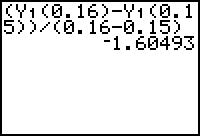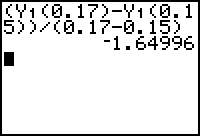In this lesson you will explore left-hand difference quotients, right-hand difference quotients, and symmetric difference quotients.
Expressions of the form
are called difference quotients because each is the quotient of two differences. Notice that each difference quotient is the ratio of the difference in output values to the difference in input values for some function f. The expressions used to compute average velocity and slopes are examples of difference quotients.
Right-hand Difference Quotients
The average velocities computed in Lesson 9.2 were examples of right-hand difference quotients. The term "right-hand" refers to the fact that each average velocity was evaluated over an interval in which (0.16, 0.716) remained fixed and the other points had x-values that were larger than 0.16 and approached 0.16 from the right. The expression below is an example of a right-hand difference quotient at t = 0.16 because t = 0.17 is to the right of t = 0.16.
Left-hand Difference Quotients
A left-hand difference quotient for a function is found by approaching the fixed point from the left.
A left-hand difference quotient for the function stored in Y1 at the point t = 0.16 can be found by using the points (0.16, Y1(0.16)) and (0.15, Y1(0.15)).
- Confirm that Y1 = -4.503x2 - 0.209x + 0.864.
- Evaluate (Y1(0.16)- Y1(0.15)) / (0.16-0.15).

The average velocity on the interval from t = 0.15 to t = 0.16 is approximately -1.60493 m/s.
Instantaneous Velocity Using Left-hand Difference Quotients
In exercise 9.2.3 the instantaneous velocity at t = 0.16 was approximated by a series of right-hand difference quotients. Those estimates seemed to approach approximately -1.65 m/s as the time intervals got smaller. Do successive left-hand difference quotients produce similar results?
9.3.1 Evaluate left-hand difference quotients over the following intervals:
t = 0.159 to t = 0.16 (elapsed time = 0.001 seconds)
t = 0.1599 to t = 0.16 (elapsed time = 0.0001 seconds)
t = 0.15999 to t = 0.16 (elapsed time = 0.00001 seconds)
Click here for the answer.
As the time intervals get smaller, the left-hand difference quotients appear to be approaching the same value as the right-hand difference quotients in 9.2.3. In general it can be shown that for a position function f with a in the domain of f, the instantaneous velocity at the point (a, f(a)) can be found by evaluating either the right-hand or left-hand difference quotients. Notice that the difference quotients in
are right-hand difference quotients if h > 0 and left-hand difference quotients if h < 0.
Symmetric Difference Quotients
A symmetric difference quotient is obtained by choosing points evenly spaced on either side of a specific value like t = 0.16. Will this produce results similar to the left- and right-hand difference quotients?
Evaluate a symmetric difference quotient at t = 0.16 using the points (0.15, Y1(0.15))
and (0.17, Y1(0.17)).
- Enter (Y1(0.17) - Y1(0.15)) / (0.17-0.15).

This result is the same as the instantaneous velocity at t = 0.16 found in Lesson 9.2 using the limit of the difference quotient.
9.3.2 Evaluate the symmetric difference quotient for the interval from t = 0.159 to t = 0.161. How does this average velocity compare to the instantaneous velocity? Click here for the answer.
Finding the Limit of the Symmetric Difference Quotient
Values that are equally spaced on either side of t = 0.16 can be written as 0.16 - h and 0.16 + h, where h is some small positive number. The corresponding points are (0.16 - h, Y1(0.16 - h)) and (0.16 + h, Y1(0.16 + h)). The general symmetric difference quotient is
The limit of the symmetric difference quotient produces the same instantaneous velocity as the limit of the one-sided difference quotient. The symmetric difference quotient generally gives a better approximation for the limit than a one-sided difference quotient with a comparable h.
For the quadratic function in this lesson, every symmetric difference quotient at t = 0.16 gave the same result. These results were each equal to the instantaneous velocity. As stated in the following theorem, this property is true for all quadratic functions.
Theorem
If the function is quadratic, a symmetric difference quotient at a point is equal to the slope of the tangent line at that point.
|
|||
|
|
|||